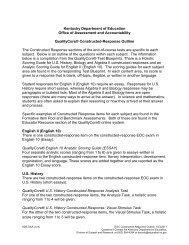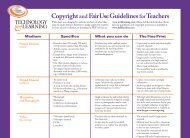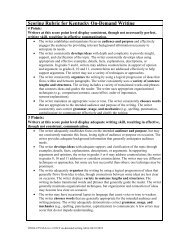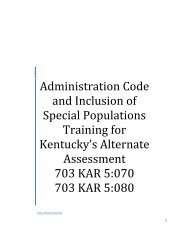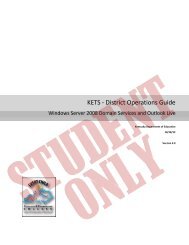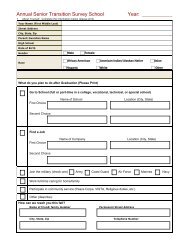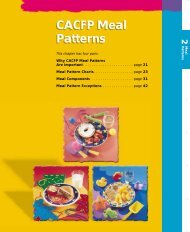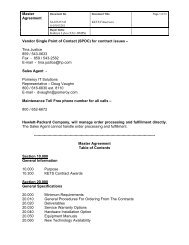Standards with Progressions grades K-HS v. 1.3 - Kentucky ...
Standards with Progressions grades K-HS v. 1.3 - Kentucky ...
Standards with Progressions grades K-HS v. 1.3 - Kentucky ...
- No tags were found...
Create successful ePaper yourself
Turn your PDF publications into a flip-book with our unique Google optimized e-Paper software.
Measurement and Data<br />
Grade 3 Grade 4 Grade 5<br />
Solve problems involving measurement and estimation of<br />
intervals of time, liquid volumes, and masses of objects.<br />
3.MD.1: Tell and write time to the nearest minute and measure<br />
time intervals in minutes. Solve word problems<br />
involving addition and subtraction of time intervals in<br />
minutes, e.g., by representing the problem on a<br />
number line diagram.<br />
3.MD.2: Measure and estimate liquid volumes and masses of<br />
objects using standard units of grams (g), kilograms<br />
(kg), and liters (l). (Note: Excludes compound units<br />
such as cm3 and finding the geometric volume of a<br />
container.) Add, subtract, multiply, or divide to solve<br />
one-step word problems involving masses or volumes<br />
that are given in the same units, e.g., by using drawings<br />
(such as a beaker <strong>with</strong> a measurement scale) to<br />
represent the problem. (Note: Excludes multiplicative<br />
comparison problems -- problems involving notions of<br />
“times as much”; see Glossary, Table 2.)<br />
Represent and interpret data.<br />
3.MD.3: Draw a scaled picture graph and a scaled bar graph to<br />
represent a data set <strong>with</strong> several categories. Solve oneand<br />
two-step “how many more” and “how many less”<br />
problems using information presented in scaled bar<br />
graphs. For example, draw a bar graph in which each<br />
square in the bar graph might represent 5 pets.<br />
3.MD.4: Generate measurement data by measuring lengths<br />
using rulers marked <strong>with</strong> halves and fourths of an inch.<br />
Show the data by making a line plot, where the<br />
horizontal scale is marked off in appropriate units—<br />
whole numbers, halves, or quarters.<br />
Geometric measurement: understand concepts of area and relate<br />
area to multiplication and to addition.<br />
3.MD.5: Recognize area as an attribute of plane figures and<br />
understand concepts of area measurement.<br />
a. A square <strong>with</strong> side length 1 unit, called “a unit<br />
square,” is said to have “one square unit” of area,<br />
and can be used to measure area.<br />
b. A plane figure which can be covered <strong>with</strong>out gaps<br />
or overlaps by n unit squares is said to have an area<br />
of n square units.<br />
Solve problems involving measurement and conversion<br />
of measurements from a larger unit to a smaller unit.<br />
4.MD.1: Know relative sizes of measurement units<br />
<strong>with</strong>in one system of units including km, m,<br />
cm; kg, g; lb, oz.; l, ml; hr, min, sec. Within a<br />
single system of measurement, express<br />
measurements in a larger unit in terms of a<br />
smaller unit. Record measurement<br />
equivalents in a two-column table. For<br />
example, know that 1 ft is 12 times as long<br />
as 1 in. Express the length of a 4 ft snake as<br />
48 in. Generate a conversion table for feet<br />
and inches listing the number pairs (1, 12),<br />
(2, 24), (3, 36), ...<br />
4.MD.2: Use the four operations to solve word<br />
problems involving distances, intervals of<br />
time, liquid volumes, masses of objects, and<br />
money, including problems involving simple<br />
fractions or decimals, and problems that<br />
require expressing measurements given in a<br />
larger unit in terms of a smaller unit.<br />
Represent measurement quantities using<br />
diagrams such as number line diagrams that<br />
feature a measurement scale.<br />
4.MD.3: Apply the area and perimeter formulas for<br />
rectangles in real world and mathematical<br />
problems. For example, find the width of a<br />
rectangular room given the area of the<br />
flooring and the length, by viewing the area<br />
formula as a multiplication equation <strong>with</strong> an<br />
unknown factor.<br />
Represent and interpret data.<br />
4.MD.4: Make a line plot to display a data set of<br />
measurements in fractions of a unit (1/2,<br />
1/4, 1/8). Solve problems involving addition<br />
and subtraction of fractions by using<br />
information presented in line plots. For<br />
example, from a line plot find and interpret<br />
the difference in length between the longest<br />
and shortest specimens in an insect<br />
collection.<br />
Convert like measurement units <strong>with</strong>in a given measurement<br />
system.<br />
5.MD.1: Convert among different-sized standard<br />
measurement units <strong>with</strong>in a given measurement<br />
system (e.g., convert 5 cm to 0.05 m), and use these<br />
conversions in solving multi-step, real world<br />
problems.<br />
Represent and interpret data.<br />
5.MD.2:<br />
Make a line plot to display a data set of<br />
measurements in fractions of a unit (1/2, 1/4, 1/8).<br />
Use operations on fractions for this grade to solve<br />
problems involving information presented in line<br />
plots. For example, given different measurements of<br />
liquid in identical beakers, find the amount of liquid<br />
each beaker would contain if the total amount in all<br />
the beakers were redistributed equally.<br />
Geometric measurement: understand concepts of volume and<br />
relate volume to multiplication and to addition.<br />
5.MD.3:<br />
5.MD.4:<br />
Recognize volume as an attribute of solid figures and<br />
understand concepts of volume measurement.<br />
a. A cube <strong>with</strong> side length 1 unit, called a “unit<br />
cube,” is said to have “one cubic unit” of<br />
volume, and can be used to measure volume.<br />
b. A solid figure which can be packed <strong>with</strong>out gaps<br />
or overlaps using n unit cubes is said to have a<br />
volume of n cubic units.<br />
Measure volumes by counting unit cubes, using<br />
cubic cm, cubic in, cubic ft, and improvised units.<br />
<strong>Kentucky</strong> Department of Education<br />
20 | P a g e




